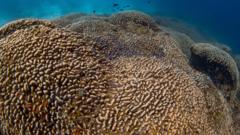The largest coral formation ever documented has been discovered in the southwest Pacific Ocean, where it remains largely untouched by the adverse effects of climate change. This colossal organism, a cluster of interconnected tiny creatures, was found during a National Geographic expedition led by videographer Manu San Felix, who was exploring untouched areas of the ocean.
The astonishing coral, located in the Solomon Islands, measures an impressive 34 meters in width and is estimated to be over 300 years old—outlasting significant historical events, including the existence of Napoleon Bonaparte. San Felix described the moment of discovery as akin to “finding a cathedral underwater,” filled with emotion and reverence for this ancient marine wonder.
By utilizing subaqueous tape measures, scientists took precise measurements of the coral, revealing its dimensions of 34 meters wide, 32 meters long, and 5.5 meters high. This remarkable specimen thrives in deeper waters, which may have shielded it from the harsher conditions experienced by shallower reefs, providing a glimmer of hope in a world where coral ecosystems face climate change's dire consequences.
During the announcement of this finding at the UN climate talks COP29 in Baku, Azerbaijan, Trevor Manemahaga, the Solomon Islands' climate minister, expressed pride in the discovery. He stressed the importance of protecting these marine resources, which are crucial to the nation's economy that heavily relies on fisheries and tourism linked to coral reefs.
As climate change continues to threaten small island nations through more severe weather events and coastal erosion, the urgency of preserving these ecosystems becomes paramount. Manemahaga highlighted the need for increased financial support from developed nations to diversify the economy and reduce reliance on industries that harm coral habitats, such as logging.
Eric Brown, a coral scientist aboard the National Geographic research vessel, noted that while surrounding shallow reefs have suffered degradation from rising sea temperatures, the health of this newly discovered coral presents a “beacon of hope.” It shines a spotlight on the resilience of corals, which provide vital habitats for diverse marine life, including shrimp, crabs, and various fish species.
The coral—identified as Pavona clavus—not only serves as a sanctuary for marine creatures but also provides insights into past oceanic conditions through its growth patterns. With recent reports indicating that 44% of corals in warm waters face extinction, the findings underscore the urgency of conservation efforts to protect these intricate ecosystems that sustain both biodiversity and human livelihoods.

















